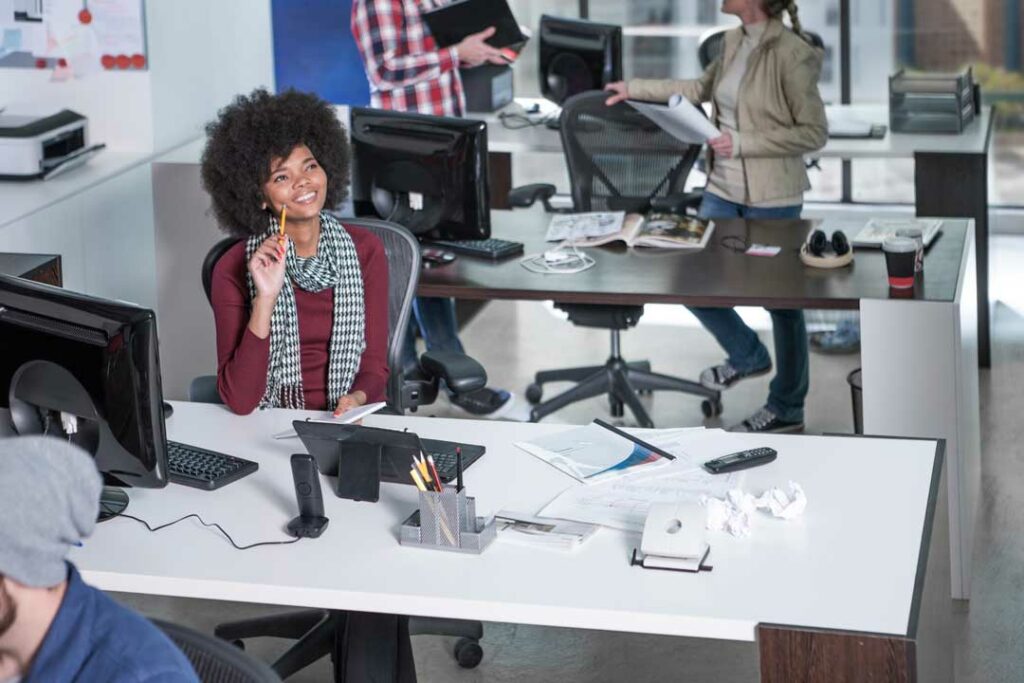Hybrid workspace solutions aren’t just convenient—they’re essential for moms and children adjusting to hybrid learning and remote work life.

The post-COVID reality has brought about a fundamental shift in how we live and work. Hybrid models, blending in-person and remote elements, have become the new norm.
This transformation has particularly impacted families, as parents juggle their professional responsibilities while supporting their children’s education. Mothers, in particular, often bear the brunt of this dual role, navigating Zoom meetings, work deadlines, and their children’s academic needs simultaneously.
Hybrid Workspace Solutions for Moms and Kids in a Hybrid Learning World
Hybrid learning combines traditional in-person instruction with online learning elements, creating a versatile learning environment for successful hybrid learning.
This model allows educators to engage with students both physically and virtually, catering to various student needs, especially remote learners unable to attend classes in person. However, this flexibility requires meticulous planning to integrate both learning formats effectively.
Homes now serve as both classrooms and offices in this new environment. Traditional home setups, designed for single-use purposes, are no longer sufficient.
Both children and working moms need hybrid workspaces that are thoughtfully designed to support their simultaneous activities. These spaces must blend productivity with flexibility, offering a seamless transition between work and learning.
Understanding the Hybrid Learning Landscape
Hybrid learning is more than just a mix of in-person and online instruction. It involves asynchronous study and technology-driven collaboration, creating a dynamic and flexible learning environment. This model affects students across different age groups, requiring them to adapt to changing schedules, platforms, and environments.

The learning space at home has become an extension of the school, demanding that parents often serve as tech support, tutors, and motivators, promoting active learning.
The hybrid learning model also necessitates a Learning Management System (LMS) to streamline the distribution of resources and track student progress.
This setup supports continuous learning and allows for an engaging learning experience that caters to diverse learning styles, enhancing the overall learning process. However, the demands placed on parents can be overwhelming, highlighting the need for multifunctional learning spaces at home to learn.
The Pressure Cooker: Working Mothers in a Hybrid World
The hybrid work environment offers numerous benefits, including enhanced work-life balance for women, allowing them to spend more time with their families. However, this flexibility comes with its own set of challenges. Working mothers often face a disproportionate load, managing:
- Zoom meetings
- Work deadlines
- Their children’s academic obligations simultaneously This multitasking can lead to burnout, distraction, and diminished productivity.

Despite the benefits of hybrid work, women often face challenges in visibility and networking opportunities, which can impede their career advancement. Research indicates that access to flexible work options is a key factor in women’s decisions to seek higher-level positions. Companies that support hybrid working models can attract a diverse top talent pool by promoting flexible job opportunities.
The physical and emotional toll on working mothers is significant. Dedicated, dual-purpose spaces can alleviate some of this stress and provide much-needed structure.
Why Traditional Home Setups Are No Longer Enough
Most homes are not designed for multifunctional use. Traditional home offices prioritize quiet and isolation, while children’s learning areas often lack ergonomic or technological support. Hybrid environments require a new kind of spatial thinking—one that blends productivity with flexibility.
Shared resources, better organization, and smart zoning strategies are essential to support parallel activities. Families need spaces that can adapt to their evolving needs, providing ergonomic solutions for work and learning.
Coworking Solutions for Working Parents
Modern coworking spaces have emerged as a solution for working parents, offering:
- A structured environment that helps them focus on work without home distractions.
- The Work Project, a high-end, design-focused coworking space where professionals—especially moms—can work in peace without sacrificing proximity to family needs.
- A supportive community and networking opportunities, enhancing productivity for working parents.
Coworking spaces provide flexibility in working hours, enabling parents to align their work responsibilities with family commitments. Amenities that bridge the gap between professional environments and family realities include:

- Private phone booths
- Quiet zones
- Lounges
- Adjacent childcare services or parent-friendly schedules
These spaces also alleviate feelings of isolation for working parents, integrating professional success with family time.
Smart Supplementation Through Private Tutoring
Hybrid learning doesn’t always meet the educational needs of every child. Services like Genius Mind offer critical academic supplements that help children stay on track while freeing up parents’ time and energy. Hybrid tutoring, which combines human and AI support, can double student learning outcomes compared to traditional methods.
Incorporating virtual or at-home tutoring into the family schedule enhances the effectiveness of hybrid learning without overburdening the parent. AI-assisted tutoring models provide personalized instruction, while human tutors offer socio-emotional support, ensuring that children receive a well-rounded education.
Designing Hybrid Workspaces: Function Meets Flexibility
Effective hybrid workspaces are designed with function and flexibility in mind. These spaces should include “zones” for different activities—quiet zones for calls and focused work, collaborative zones for hands-on learning or brainstorming, breakout rooms for switching contexts. The design of hybrid workspaces aims to facilitate both in-person collaboration and remote work, using adaptable furniture and technology for seamless interaction.
Key features of hybrid work environments include:
- Height-adjustable desks
- Acoustic panels
- Flexible seating
- Ample lighting

Creating hybrid work environments often involves reconfiguring existing office spaces to promote collaboration while allowing flexibility for remote working in a hybrid workplace. The hybrid model balances traditional office elements with flexible arrangements, catering to employees who prefer to work both remotely and onsite.
Effective hybrid workspace design incorporates technology that enables easy booking of meeting rooms and shared resources for remote and in-office Microsoft Teams.
Creating Micro-Environments for Children
Children benefit from hybrid workspaces that are stimulating yet structured. Micro-environments for children can be designed as small, supervised learning activities that promote exploration and socialization among peers. These spaces should include familiar objects and soft materials to ease transitions between schoolwork and downtime.
Kids21 offers plush toys and comforting sensory aids that make a child’s hybrid learning zone feel secure and inviting, fostering a sense of knowledge. Microschools, which emphasize personalized learning experiences tailored to individual needs, can vary in location, including homes, libraries, and community spaces.
The Tech Infrastructure Behind a Successful Hybrid Setup
A successful hybrid setup requires a robust digital infrastructure. Important components include:

- Shared calendars
- Noise-canceling headphones
- Password managers
- Parental control apps
- A reliable high-speed internet connection
These necessary tools and other tools help families stay on the same page, contributing to independence and efficiency for both moms and kids. A reliable high-speed internet connection is essential for effective communication and learning in hybrid classrooms, following key principles and enhancing skills.
Tech planning should be integrated into spatial planning from the beginning. This includes:
- Ensuring multiple devices and charging stations are available
- Utilizing video collaboration tools and interactive whiteboards to enhance engagement
- Using external microphones and high-quality cameras to provide clear visuals and audio for remote participants, supported by a robust technology infrastructure.
Coordinating Schedules Without Chaos
Time management and synchronization are crucial in hybrid households. Overlapping responsibilities and online classes can cause chaos without proper planning. Implementing a structured hybrid schedule helps avoid confusion about when employees should work in the office versus remotely.
Strategies like time blocking, visual schedules, or using digital whiteboards to display the day’s agenda can help reduce stress and reinforce routine. Smart scheduling optimizes office space use and ensures that teams are present during crucial collaboration days, enhancing problem solving with effective strategies.
Comfort, Wellness, and Sensory Balance
Spaces that feel good are as important as those that function well. The psychological benefits of biophilic design—incorporating plants and natural light—along with soft textures and clear organization, cannot be overstated.

Equitable learning environments enhance students’ comfort and wellness, allowing them to feel secure and engaged in the right environment.
Wellness inclusions like a yoga mat corner, a hydration station, or a reading nook can significantly enhance comfort and security. Products like Kids21’s Jellycat plushies for children or ergonomic seating for adults ensure that both moms and children feel comfortable and secure in their hybrid environments.
When both feel at ease, learning and working become more effective.
Community as a Cornerstone of Hybrid Success
The isolation of hybrid models can be mitigated through community engagement. This includes coworking peers, parental networks, or student learning pods. Community-driven solutions support accountability, emotional health, and creativity.
Fostering opportunities for students to encourage collaboration meaningfully, regardless of their physical location, is essential for creating a cohesive community and unified classroom culture, promoting active participation, peer to peer learning, social interaction, collaborative efforts, equal participation, group discussions, and allowing students to actively participate in seamless collaboration.
Hybrid workspaces, whether at home or in coworking environments like The Work Project, can be designed to include shared or communal experiences without losing privacy.
Technological tools play a crucial role in fostering connections among students, facilitating participation in hybrid courses. Augmented and virtual reality technologies can help recreate human interactions that are often lacking in remote learning.
The Economic and Social Impact of Equitable Hybrid Support
Creating supportive hybrid environments for moms has broader economic and social implications:
- Enables mothers to work and parent effectively, contributing to economic stability and gender equality.
- Helps alleviate commuting barriers for individuals with disabilities.
- Enables better integration of individuals with disabilities into the workforce.

Flexible working arrangements can improve work-life balance, leading to higher employee engagement and reduced turnover rates. Policy gaps, such as subsidies for coworking memberships or tax incentives for learning materials, still need to be addressed to fully support working parents in hybrid environments.
How to Create Hybrid Workspaces That Support Learning and Work at Home
Hybrid learning and hybrid work are not temporary trends but long-term shifts that require thoughtful, inclusive design. Hybrid workspaces should serve both cognitive and emotional needs, making space—literally and figuratively—for growth, learning, and balance. Families, employers, and educators must invest in hybrid setups that promote sustainable success for both moms and children.
As we move forward, the question remains: What does your ideal hybrid space look like—and who does it serve? Addressing these diverse needs will help create environments that support the well-being and success of all family members.
Frequently Asked Questions
Hybrid learning is an educational approach that combines in-person and online instruction, enabling educators to effectively engage with students regardless of their physical location. This model enhances flexibility and accessibility in the learning experience.
Coworking spaces significantly benefit working parents by creating a distraction-free environment that enhances focus, while also providing flexibility in work hours and essential amenities like private phone booths and childcare services. This combination allows parents to balance their professional and personal responsibilities more effectively.
Traditional home setups fall short for hybrid environments because they focus on quiet and isolation, neglecting essential ergonomic and technological support needed for flexibility and productivity. Adapting workspaces to meet these demands is crucial for effective performance in a hybrid model.
Incorporating private tutoring into hybrid learning significantly enhances academic support by providing personalized instruction and socio-emotional assistance, ensuring students stay on track without adding pressure on parents. This tailored approach fosters a more effective and enriching learning experience.
To support a successful hybrid setup, robust technology infrastructure is crucial, including high-speed internet, video collaboration tools, and shared calendars. These tools enhance communication and collaboration, ensuring seamless interaction between remote and in-office team members.

Jessi is the creative mind behind The Coffee Mom, a popular blog that combines parenting advice, travel tips, and a love for all things Disney. As a trusted Disney influencer and passionate storyteller, Jessi’s authentic insights and relatable content resonate with readers worldwide.
